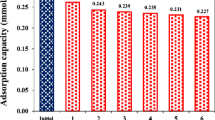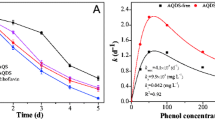Abstract
Azo dye reduction at 55°C by thermophilic anaerobic granular sludge was investigated distinguishing between the biotic and abiotic mechanisms. The impact of the redox mediator anthraquinone-2,6-disulfonate (AQDS) on colour removal and co-substrate oxidation was also investigated. Metabolic activities of the thermophilic inoculum induced a fast azo dye reduction and indicated a biotic predominance in the process. The addition of co-substrate enhanced the decolourisation rates 1.7-fold compared with the bottles free of co-substrate. Addition of AQDS together with co-substrate enhanced the k value 1.5-fold, compared with the incubation containing co-substrate in the absence of AQDS. During a comparative study between sludge samples incubated under mesophilic (30°C) and thermophilic (55°C) conditions, the decolourisation rate at 55°C reached values up to sixfold higher than at 30°C. Biological treatment at 55°C showed a fast initial generation of reducing compounds via co-substrate oxidation, with AQDS increasing the azo dye reduction rate in all the incubations tested. Nevertheless, high concentrations of AQDS showed severe inhibition of thermophilic acetate and propionate oxidation and methane production rates. These promising results indicate that there may be good prospects for thermophilic anaerobic treatment of other reductive transformations such as reduction of nitroaromatics and dehalogenation.







Similar content being viewed by others
References
APHA (1998) Standard methods for the examination of water and wastewater, 20th edn. American Public Health Association, Washington, D.C.
Beydilli MI, Pavlostathis SG, Tincher WC (1998) Decolourisation and toxicity screening of selected reactive azo dyes under methanogenic conditions. Water Sci Technol 38:225–232
Bromley-Challenor KCA, Knapp JS, Zhang Z, Gray NCC, Hetheridge MJ, Evans MR (2000) Decolourisation of an azo dye by unacclimated activated sludge under anaerobic conditions. Water Res 34:4410–4418
Cervantes FJ, van der Velde S, Lettinga G, Field JA (2000) Competition between methanogenesis and quinone respiration for ecologically important substrates in anaerobic consortia. FEMS Microbiol Ecol 34:161–171
Field JA, Brady J (2002) Riboflavin as a redox mediator accelerating the reduction of the azo dye mordant yellow 10 by anaerobic granular sludge. In: VII Latin American workshop and symposium on anaerobic digestion. Merida, Mexico, pp 343–350
Field JA, Cervantes FJ, Van der Zee FP, Lettinga G (2000) Role of quinones in the biodegradation of priority pollutants: a review. Water Sci Technol 42:215–222
Gingell R, Walker R (1971) Mechanisms of azo reduction by Streotococcus faecalis: the role of soluble flavins. Xenobiotica 3:231–239
Kashefi K, Tor JM, Holmes DE, Van Praagh CVG, Reysenbach AL, Lovley DR (2002) Geoglobus ahangari gen. Nov., sp. Nov., a novel hyperthermophilic archaeon capable of oxidizing organic acids and growing autotrophically on hydrogen with Fe(III) serving as the sole electron acceptor. Int J System Evol Microbiol 52:719–728
Keck A, Klein J, Kudlich M, Stolz A, Knackmuss HJ, Mattes R (1997) Reduction of azo dyes by redox mediators originating in the naphtalenesulfonic acid degradation of Sphingomonas sp. strain BN6. Appl Environ Microbiol 63:3684–3690
Keck A, Rau J, Reemtsma T, Mattes R, Stolz A, Klein J (2002) Identification of quinoide redox mediators that are formed during the degradation of naphthalene-2-sulphonate by Sphingomonas xenophaga BN6. Appl Environ Microbiol 68:4341–4349
Kudlich M, Keck A, Klein J, Stolz A (1997) Localization of the enzyme system involved in anaerobic reduction of azo dyes by Sphingomonas sp. strain BN6 and effect of artificial redox mediators on the rate of azo dye reduction. Appl Environ Microbiol 63:3691–3694
Lovley DR, Kashefi K, Vargas M, Tor JM, Blunt-Harris EL (2000) Reduction of humic substances and Fe(III) by hyperthermophilic microorganisms. Chem Geol 169:289–298
Rau J, Stolz A (2003) Oxygen-insensitive nitroreductase NfsA and NfsB of Escherichia coli function under anaerobic conditions as lawsone-dependent azo reductases. Appl Environ Microbiol 69:3448–3455
Rau J, Knackmuss HJ, Stolz A (2002) Effects of different quinoide redox mediators on the anaerobic reduction of azo dyes by bacteria. Environ Sci Technol 36:1497–1504
Russ R, Rau J, Stolz A (2000) The function of cytoplasmatic flavin reductases in the reduction of azo dyes by bacteria. Appl Environ Microbiol 66:1429–1434
Stams AJM (1994) Metabolic interactions between anaerobic bacteria in methanogenic environments. Antonie van Leeuwenhoek 66:271–294
Stolz A (2001) Basic and applied aspects in the microbial degradation of azo dyes. Appl Microbiol Biotechnol 56:69–80
Trüper HG, Schlegel HG (1964) Sulphur metabolism in Thiorhodaceae-I, quantitative measurements on growing cells of Chromatium okenii. Antonie van Leeuwenhoek 30:225–238
Van der Zee FP, Lettinga G, Field JA (2001) Application of redox mediators to accelerate the transformation of reactive azo dyes in anaerobic bioreactors. Biotechnol Bioeng 75:691–701
Van der Zee FP, Bisschops IAE, Blanchard VG, Bouwman RHM, Lettinga G, Field JA (2003) The contribution of biotic and abiotic processes during azo dye reduction in anaerobic sludge. Water Res 37:3098–3109
Van Lier JB, Hulsbeek J, Stams AJM, Lettinga G (1993a) Temperature susceptibility of thermophilic methanogenic sludge: implications for reactor start-up and operation. Bioresour Technol 44:227–235
Van Lier JB, Grolle KCF, Frijters CTMJ, Stams AJM, Lettinga G (1993b) Effects of acetate, propionate, and butyrate on the thermophilic anaerobic degradation of propionate by methanogenic sludge and defined cultures. Appl Environ Microbiol 59:1003–1011
Van Lier JB, Rebac S, Lens P, van Bijnen F, Oude Elferink SJW, Stams AJM, Lettinga G (1997) Anaerobic treatment of partly acidified wastewater in a two-stage expanded granular sludge bed (EGSB) system at 8°C. Water Sci Technol 36:317–324
Yoo ES, Libra J, Wiesmann U (2000) Reduction of azo dyes by Desulfovibrio desulfuricans. Water Sci Technol 41:15–22
Zinder SH (1990) Conversion of acetic acid to methane by thermophilies. FEMS Microbiol Ecol 75:125–138
Zollinger H (1987) Colour Chemistry — Synthesis, properties and applications of organic dyes and pigments. VCH, New York
Acknowledgement
This work was supported by the "Conselho Nacional de Desenvolvimento Científico e Technológico—CNPq" (Project no. 200488/01-5), an organisation of the Brazilian Government for the development of Science and Technology.
Author information
Authors and Affiliations
Corresponding author
Rights and permissions
About this article
Cite this article
dos Santos, A.B., Cervantes, F.J. & van Lier, J.B. Azo dye reduction by thermophilic anaerobic granular sludge, and the impact of the redox mediator anthraquinone-2,6-disulfonate (AQDS) on the reductive biochemical transformation. Appl Microbiol Biotechnol 64, 62–69 (2004). https://doi.org/10.1007/s00253-003-1428-y
Received:
Revised:
Accepted:
Published:
Issue Date:
DOI: https://doi.org/10.1007/s00253-003-1428-y




